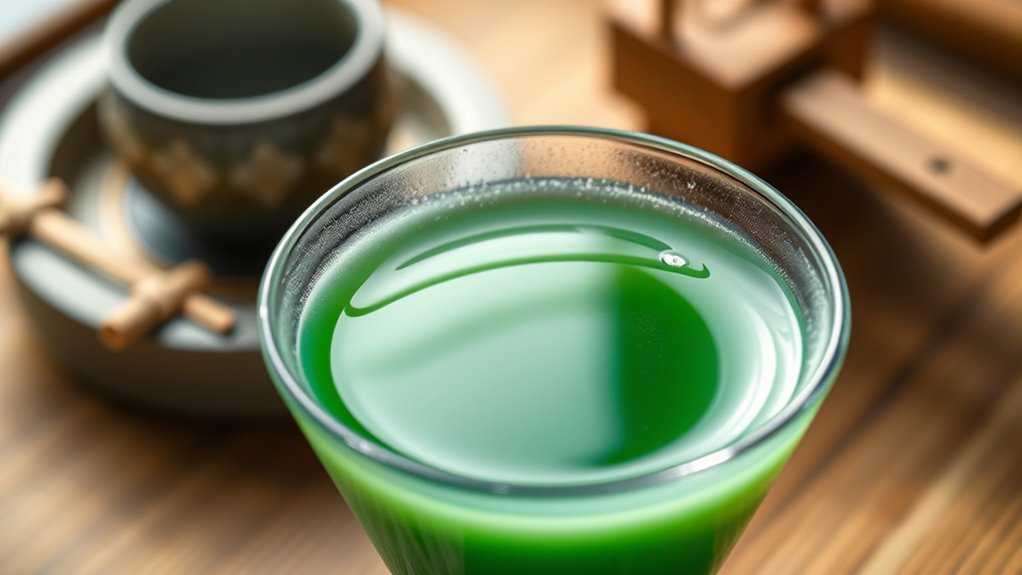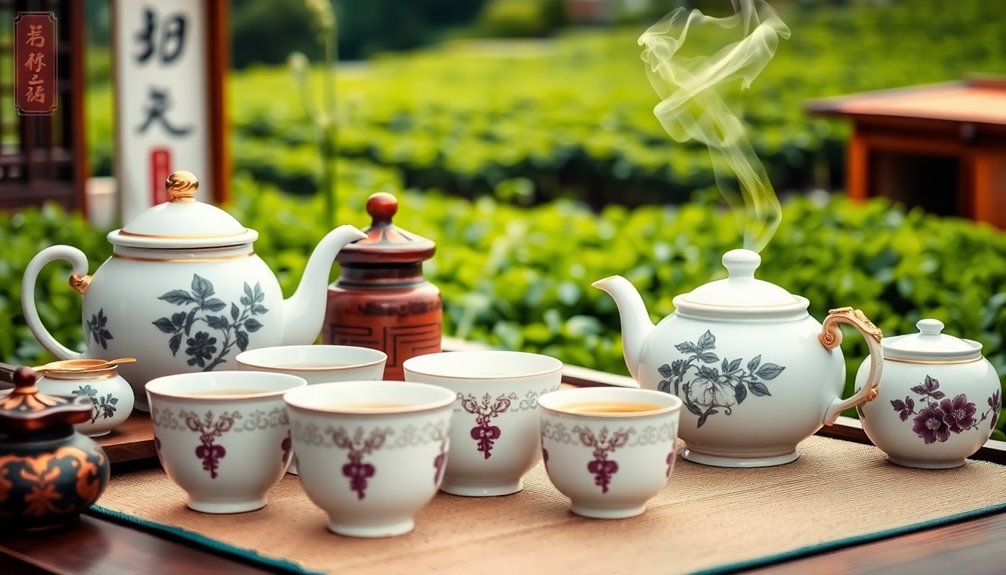In high-grade Gyokuro, umami is the key that defines its rich, smooth, and complex flavor. It results from careful shading, early harvesting, and gentle processing that boost amino acids, especially theanine. This savory taste balances sweetness and vegetal notes, creating a harmonious, full-bodied experience. If you want to uncover how cultivation and craftsmanship bring out this unique flavor, keep exploring the fascinating details behind Gyokuro’s umami.
Key Takeaways
- Umami is the defining savory flavor that distinguishes high-grade Gyokuro from other green teas.
- Shading cultivation increases amino acids, especially theanine, which enhances Umami content.
- Gentle steaming and careful shaping preserve and highlight the tea’s rich Umami profile.
- The balanced Umami creates a smooth, complex taste that elevates the overall tea experience.
- Higher Umami levels result in a rounded, savory flavor that complements sweetness and vegetal notes.

Umami plays a crucial role in shaping Gyokuro’s distinctive flavor, setting it apart from other green teas. This savory taste isn’t accidental; it results from careful cultivation and processing that emphasize flavor enhancement. One of the key factors affecting umami levels is the harvesting technique. Unlike other teas, Gyokuro is typically harvested early in the season, often just before the tea leaves fully mature. This careful timing ensures the leaves are young and tender, which contributes to a richer umami profile. The traditional method involves shading the tea plants with woven cloths or straw coverings for about three weeks before harvest. This shading process reduces sunlight exposure, leading to increased chlorophyll and amino acids, especially the amino acid called theanine. The higher the theanine content, the more pronounced the umami taste becomes. As a result, the harvesting techniques directly influence the flavor enhancement of Gyokuro, making it smoother, more complex, and deeply savory.
Once the leaves are picked, the way they’re processed further enhances their umami qualities. Gyokuro undergoes gentle steaming soon after harvest, a step that preserves its delicate flavor profile. This steaming process not only prevents oxidation but also helps retain the amino acids responsible for umami. Unlike other green teas, Gyokuro’s leaves are carefully shaped by hand into thin, needle-like shapes, which maximize surface area and facilitate even infusion. This meticulous handling ensures that the tea’s flavor is rich and consistent, allowing the umami to shine through prominently in each brew. When prepared correctly, Gyokuro offers a balanced flavor that combines sweetness, vegetal notes, and a lingering savory taste, all underpinned by the umami.
In tasting Gyokuro, you’ll notice that its umami isn’t overpowering but rather a harmonious core that elevates the tea’s overall flavor. This complexity is a direct result of the interplay between the shading during cultivation and the precise harvesting techniques used. Every step is designed to boost the amino acid content, which enhances flavor, smooths bitterness, and creates a rounded, full-bodied experience. So, when you appreciate Gyokuro, recognize that its rich umami flavor is no accident; it’s the product of intentional cultivation, careful harvesting, and expert processing—all working together to deliver a truly exceptional green tea.
Frequently Asked Questions
How Does Soil Quality Influence Umami Levels in Gyokuro?
Soil quality directly impacts umami levels in gyokuro by affecting soil nutrients and microbial activity. Rich, well-balanced soil provides essential nutrients that plants absorb, boosting amino acids responsible for umami. Healthy microbial activity enhances nutrient availability, leading to more flavorful leaves. When soil is nutrient-rich and teeming with microbes, your gyokuro benefits from heightened umami, delivering a richer, more savory taste that elevates your tea experience.
Are There Specific Harvesting Methods That Enhance Umami in Gyokuro?
You can enhance umami in gyokuro by using specific harvesting methods like shade cultivation and leaf plucking. Shade cultivation increases chlorophyll and amino acids, boosting umami content. Leaf plucking at the right time helps develop richer flavors by encouraging new, tender leaves. Together, these techniques maximize amino acids and guarantee your gyokuro has a deeper, more savory umami flavor, elevating your tea experience.
What Are the Best Storage Techniques to Preserve Gyokuro’s Umami?
Imagine capturing a fleeting moment—your gyokuro’s delicate umami. To preserve it, you should vacuum seal the tea and store it in a cool, dark place, away from light and humidity. These techniques lock in freshness and prevent oxidation, ensuring your gyokuro retains its rich umami flavor. Proper storage isn’t just practical; it’s a way to protect the essence of this prized tea for every perfect brew.
Can Umami Intensity Vary Between Different Gyokuro Producers?
You might notice umami intensity varies between gyokuro producers due to differences in their techniques. Producer methods, like shading duration and leaf harvesting, impact flavor consistency and umami richness. Some producers focus on precise cultivation to enhance umami, while others may prioritize different flavor profiles. As a result, each gyokuro can offer a unique umami experience, reflecting the craftsmanship and approach of its maker.
How Does Brewing Temperature Affect Umami Extraction in Gyokuro?
Imagine opening a treasure chest—your gyokuro’s umami flavor depends on water temperature and steeping duration. Lower water temperatures, around 50°C, delicately extract umami, while higher temperatures risk bitterness. Longer steeping releases more umami, but too long can overpower the balance. You should experiment with water temperature and steeping time to find your ideal extraction, ensuring a rich, savory sip every time.
Conclusion
You might be surprised to learn that gyokuro contains up to five times more umami compounds than regular green teas. This rich umami not only enhances its flavor but also offers health benefits like improved digestion. By appreciating this unique taste, you’ll better understand why gyokuro is prized among tea connoisseurs worldwide. So next time you sip, remember, you’re enjoying a centuries-old tradition that’s packed with a powerful umami punch.










